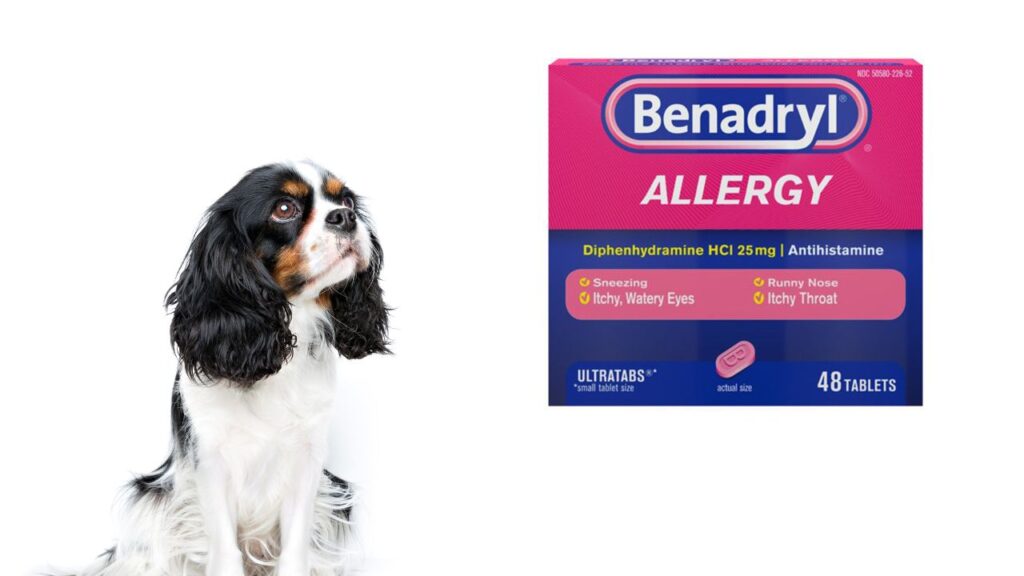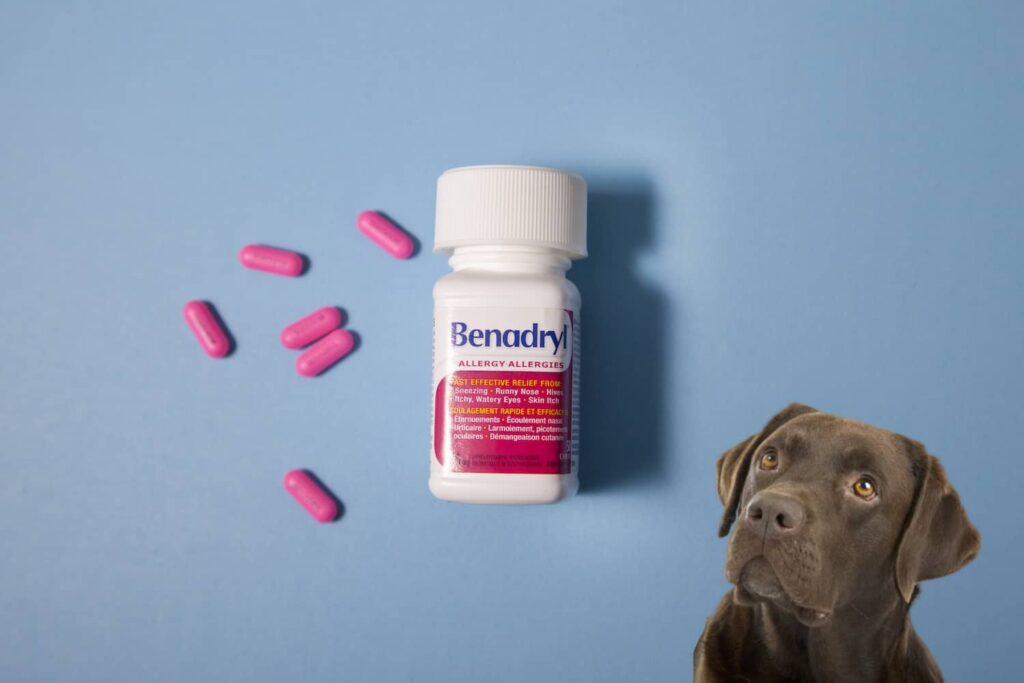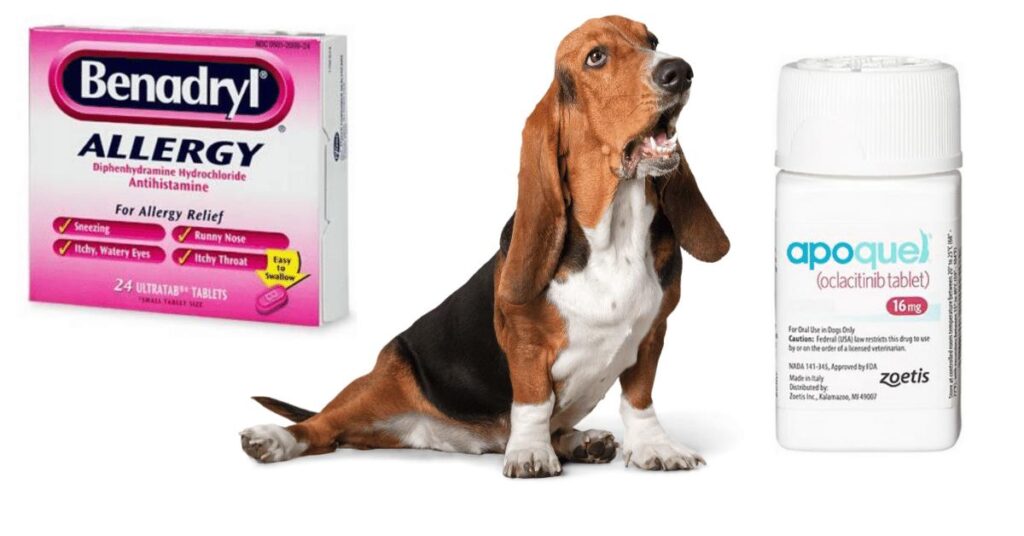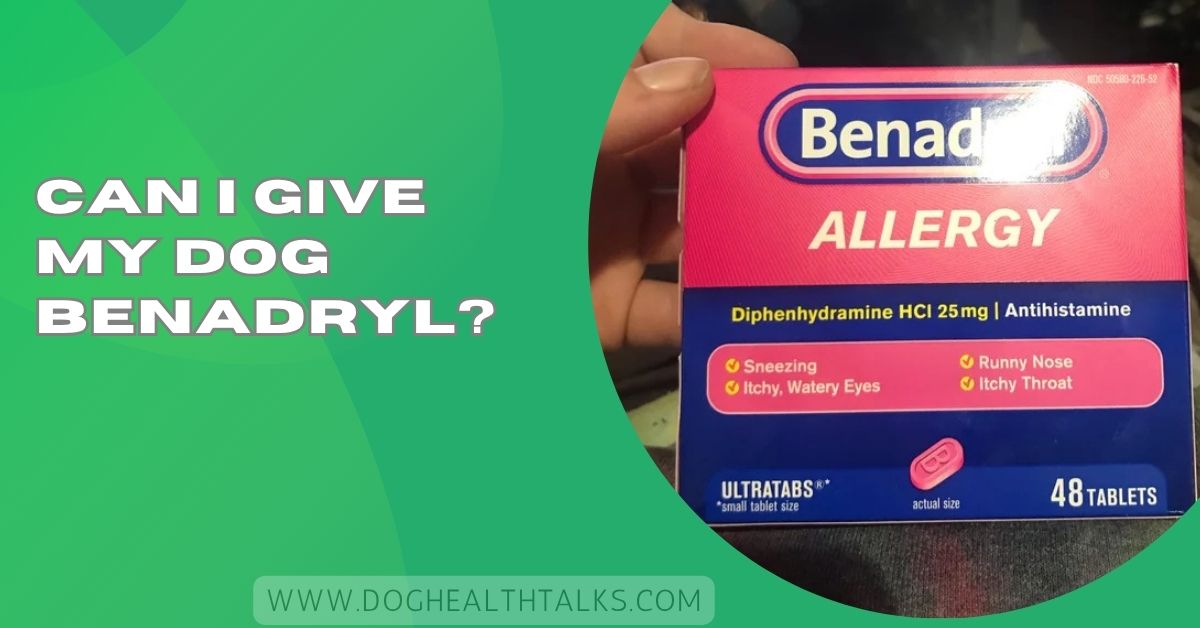As loving dog parents, we always want our furry friends to feel their best — especially when allergies, itching, or anxiety strike.
Yes, you can give your dog Benadryl. It’s generally safe when using plain diphenhydramine at a dosage of 1–2 milligrams per pound of your dog’s body weight. Always consult your veterinarian first.
But before reaching for that pink pill, it’s important to understand the safe dosage, side effects, and when it’s right to use. This guide will help you give Benadryl responsibly and confidently, keeping your dog safe, calm, and healthy.
Benadryl, known by its generic name Diphenhydramine, is an antihistamine that blocks the effects of histamine — the compound responsible for allergic reactions. It’s been trusted by veterinarians for decades to ease symptoms like itching, watery eyes, sneezing, and swelling in dogs.
When your dog’s body reacts to allergens such as pollen, dust, or insect bites, histamines are released, causing irritation. Benadryl helps calm these reactions by reducing the body’s histamine response. It also offers mild sedation, which can help soothe dogs during stressful moments.
While Benadryl is safe for most dogs, it’s not a “one-size-fits-all” medication. Always consult your veterinarian before giving it to ensure it’s the right choice for your pet’s condition and health history.

Yes — Benadryl can be very helpful for mild allergies in dogs. It’s often recommended for symptoms like:
- Itchy or red skin
- Watery eyes
- Runny nose
- Sneezing
- Swelling from insect bites
Many pet owners use Benadryl to treat seasonal allergies caused by pollen, dust mites, or mold. It can also help with allergic reactions to vaccines, food, or bug bites.
However, if your dog shows signs of a severe allergic reaction — such as facial swelling, hives, vomiting, or difficulty breathing — do not wait. Take your dog to the veterinarian immediately. Severe reactions need stronger medications like steroids or epinephrine, not just Benadryl.
Remember: Benadryl helps manage symptoms, not the root cause of allergies. Your vet can suggest allergy testing and long-term solutions such as special diets, supplements, or medicated shampoos.
Also Reaad: How To Relieve Dog Itching After Grooming Home Remedies
This is a common question — and the answer is yes, but with caution. Benadryl may make some dogs sleepy, which can seem helpful for anxiety. But it doesn’t actually treat anxiety itself.
If your dog is anxious during thunderstorms, fireworks, or travel, Benadryl might only take the edge off — and for some dogs, it can even cause hyperactivity instead of calmness.
True anxiety often requires a combination of behavioral training, environment management, and sometimes vet-prescribed medications. Your vet might recommend alternatives such as:
- Dog anxiety vests (like ThunderShirts)
- Calming pheromone sprays or diffusers
- Prescription medications like Clomicalm or Sileo
So, while Benadryl might help your dog nap through a car ride, it’s not a reliable solution for anxiety in the long run.
Yes — when used properly, Benadryl is generally safe for most dogs. It’s widely used in veterinary medicine and has a strong safety record. However, there are exceptions.
Dogs with certain health conditions should not take Benadryl, such as:
- Heart disease
- High blood pressure
- Glaucoma
- Seizure disorders
- Lung disease
- Urinary problems
- Pregnancy
Also, if your dog takes other medications, like antifungals or antidepressants, check with your vet first to avoid harmful interactions.
Safety tip: Always use plain Benadryl (Diphenhydramine only) — not versions combined with Tylenol, decongestants, or other ingredients. These combinations can be toxic to dogs.

Benadryl’s side effects are usually mild and short-lived. Common reactions include:
- Drowsiness or sleepiness
- Dry mouth
- Slight loss of coordination
But in higher doses or sensitive dogs, you might notice:
- Agitation or hyperactivity
- Slow breathing
- Vomiting or diarrhea
- Loss of appetite
- Seizures (in rare cases)
If your dog seems unsteady, excessively tired, or shows unusual behavior after taking Benadryl, contact your vet immediately.
The good news is that Benadryl overdoses are rare and usually reversible with prompt treatment. Keeping your vet informed ensures your dog stays safe and healthy.
The general dosage recommended by veterinarians is 1 milligram (mg) per pound of body weight.
That means:
- A 10-pound dog → 10 mg
- A 25-pound dog → 25 mg
- A 50-pound dog → 50 mg
Dogs can take Benadryl 2 to 3 times per day, about every 8–12 hours.
But dosage can vary depending on your dog’s breed, health, and medical history — which is why it’s crucial to confirm the exact dose with your vet before giving any medication.
Benadryl tablets usually come in 25 mg or 50 mg doses. You can split tablets to achieve the correct amount for smaller dogs.
Example:
A 12-pound dog may only need half of a 25 mg tablet.
For larger dogs, you can give multiple tablets to reach the correct dose, but always double-check that you’re not exceeding the safe range.
Tip: Hide the tablet inside a pill pocket or your dog’s favorite treat to make it easier to swallow.
Must Read: What Home Remedy Kills Maggots On Dogs – Don’t Miss Guide!
If your dog is tiny or hates pills, children’s Benadryl can be a lifesaver.
- Chewable Benadryl contains 12.5 mg of Diphenhydramine per tablet.
- Liquid Benadryl contains 2.5 mg per ml, making it ideal for small breeds.
Always use a syringe or dropper to measure the correct amount — don’t guess!
And make sure the children’s version doesn’t include xylitol or alcohol, which can be toxic to dogs.
Benadryl can be given every 8 to 12 hours — meaning two or three times daily.
However, never give extra doses if your dog seems drowsy or unwell. Consistency and proper timing are more effective than overmedicating.
For chronic allergies, your vet might recommend daily use, but only under supervision. For one-time issues like insect stings or travel sickness, a single dose is often enough.
Always track doses in a notebook or app to avoid mistakes — especially if multiple family members care for your dog.

Absolutely! If Benadryl isn’t working or your vet advises against it, there are many safe and effective alternatives:
- Zyrtec (Cetirizine) — gentle and long-lasting.
- Apoquel — prescription allergy relief for chronic cases.
- Allergy shampoos like Douxo or DermaBenSs.
- Omega-3 supplements to support skin and immune health.
- Sileo, Reconcile, or Clomicalm — vet-prescribed for long-term calm.
- Natural calming treats with chamomile or L-theanine.
- Thundershirt vests for comfort during loud events.
- Cerenia (Maropitant Citrate) — FDA-approved for dogs.
Each dog is unique, so it’s best to work with your vet to find what fits your dog’s specific needs.
Benadryl is usually safe, but an overdose or allergic reaction can be dangerous. Always check the correct dosage and consult your veterinarian before administering it. Every dog’s body reacts differently to medication.
Enter your dog’s weight to calculate the safe Benadryl (Diphenhydramine) dosage. Always consult your vet before giving any medication.
The general Benadryl dosage for dogs is 1 mg per pound of body weight, given two to three times daily. Always use plain diphenhydramine and consult with your veterinarian for your dog’s specific needs.
Yes, Benadryl can help alleviate itching caused by allergies or insect bites. It eases mild skin irritation and swelling. However, if the itching continues or worsens, your dog should be checked by a veterinarian.
Read Out: How To Strengthen Dogs Nails – Easy Vet-Approved Tips!
You can administer Benadryl every 8 to 12 hours, which translates to two or three times a day. Always follow your vet’s advice, and never increase the dose without professional guidance.
Benadryl is safe for short-term use, such as treating allergies or insect bites. For long-term allergies, consult your veterinarian about alternative treatments to minimize side effects from daily Benadryl use.
Daily use of Benadryl is not recommended unless your veterinarian approves it. Long-term use can cause drowsiness or reduce the effectiveness of this medication. Always ask your veterinarian for safer allergy management options.
Yes, Benadryl can make most dogs feel sleepy or calm. It’s a common side effect of the medicine. However, some dogs may experience the opposite and become restless or hyperactive.
Only plain Benadryl, containing diphenhydramine, is safe for dogs. Avoid liquid or combination formulas with added ingredients like alcohol or decongestants.
The safe dose is 1 milligram per pound of your dog’s body weight, given every 8 to 12 hours as needed.
Yes, Benadryl can help relieve mild itching caused by allergies, insect bites, or skin irritation, but always consult your veterinarian first.
Yes, the pink Benadryl tablets containing diphenhydramine only are usually safe for dogs. Always confirm ingredients before giving any medicine.
Avoid Benadryl if your dog has heart disease, glaucoma, high blood pressure, or urinary issues. Always ask your vet first.
There isn’t a separate dog version. Dogs take the same plain diphenhydramine used for humans but in smaller, vet-approved doses.
You can give Benadryl or vet-approved antihistamines for mild itching. For severe allergies, your vet may recommend special allergy medicine.
Both can help allergies, but Zyrtec causes less drowsiness. Ask your vet which option best fits your dog’s needs and health.
Benadryl usually starts working within 30 minutes, helping your dog feel calmer and less itchy for several hours afterward.
Common safe antihistamines for dogs include Benadryl, Zyrtec, and Claritin, but always confirm dosage and safety with your veterinarian.
Benadryl can be a safe and effective way to bring relief to your dog when allergies, itching, or mild anxiety strike. When used correctly — and under your vet’s guidance — it can ease discomfort, calm reactions, and help your furry friend feel better fast.
However, it’s not a cure-all. Every dog is different, and factors like age, weight, health conditions, and other medications play a big role in how Benadryl works. Always use plain diphenhydramine only, follow the 1 mg per pound dosage rule, and consult your veterinarian before giving any medication.
If your dog’s symptoms persist or worsen, don’t rely solely on Benadryl. Your vet can recommend safer, long-term solutions for allergies, anxiety, or skin problems.
